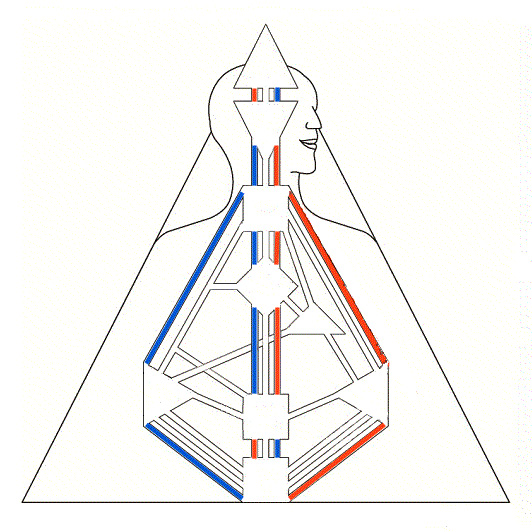Collective Circuit (Collective Circuit in Human Design)
The Collective Circuit is one of the three main circuits in the Human Design system, focusing on collective energy and social processes. Unlike the Individual Circuit, which emphasizes the uniqueness of the individual and their personal evolution, the Collective Circuit centers on communal experience and the transmission of knowledge that benefits the entire community, its well-being, and its development.
Key Characteristics of the Collective Circuit:
- Knowledge and Tradition:
The Collective Circuit is connected to gathering, processing, and sharing knowledge aimed at enriching and advancing society as a whole. This is where ideas and solutions emerge that can benefit larger groups of people. - Process of Social Evolution:
The Collective Circuit plays a key role in social evolution—not only through innovation but also by preserving and developing traditions. The energy of this circuit supports building a common future based on the experiences and wisdom of past generations. - Logic and Patterns:
Within the Collective Circuit, there is a tendency to analyze and search for logical patterns in the surrounding reality. These patterns help communities draw conclusions and create predictable structures.
Subcircuits of the Collective Circuit:
The Collective Circuit is divided into two subcircuits, each with its unique channels:
1. Logic and Understanding Subcircuit
Theme: “Sharing knowledge and understanding through patterns”
This subcircuit focuses on identifying systems and patterns that help understand the present and predict the future based on past data.
- Channel 4-63 (Logic Channel): Connects the Head Center to the Ajna Center. It’s linked to doubt, questions, and the need to find answers through logical reasoning and analytical thinking.
- Channel 5-15 (Rhythm Channel): Connects the Sacral Center to the G Center (Identity). It represents the natural rhythm and sense of timing, harmonizing with life’s natural cycles.
- Channel 7-31 (Alpha Channel): Connects the G Center (Identity) to the Throat Center. This channel offers leadership skills and the ability to guide others with vision and influence.
- Channel 9-52 (Focus Channel): Connects the Sacral Center to the Root Center. It provides the ability to focus on details and maintain concentration on tasks to achieve long-term goals.
- Channel 16-48 (Talent Channel): Connects the Throat Center to the Spleen Center. It supports skill development through practice and refinement, laying the foundation for mastery and recognition.
- Channel 17-62 (Acceptance Channel): Connects the Ajna Center to the Throat Center. This channel enhances the ability to express logical thoughts and analyze, helping to recognize patterns in the world.
- Channel 18-58 (Judgment and Optimization Channel): Connects the Spleen Center to the Root Center. It’s linked to the energy of improvement and system optimization through analysis and constructive criticism.
2. Abstract Subcircuit
Theme: “Sharing knowledge through life experiences and reflection”
This subcircuit focuses on processing past experiences to find meaning and understanding, helping create a shared vision for the future.
- Channel 11-56 (Curiosity Channel): Connects the Ajna Center to the Throat Center. It brings the ability to express memories and share them with others, enriching life experiences.
- Channel 13-33 (Narrative Channel): Connects the G Center (Identity) to the Throat Center. This channel enables active listening to stories and experiences of others and sharing reflections with the community.
- Channel 29-46 (Discovery Channel): Connects the Sacral Center to the G Center. It’s associated with engaging in new experiences and finding life’s meaning through full commitment to life’s “journeys.”
- Channel 30-41 (Recognition Channel): Connects the Solar Plexus Center (Emotions) to the Root Center. It’s tied to intense emotional experiences, the pursuit of dreams, and passion.
- Channel 35-36 (Adventure & Crisis Channel): Connects the Throat Center to the Solar Plexus Center. It’s associated with the need to seek adventures and emotional experiences.
- Channel 42-53 (Maturation Channel): Connects the Sacral Center to the Root Center. This channel represents cycles and the process of completing projects before moving on to new life stages.
- Channel 47-64 (Abstraction Channel): Connects the Head Center to the Ajna Center. It’s focused on processing past experiences and uncovering their meaning, often through retrospection.
The Role of the Collective Circuit in Individual Design:
For individuals with active Channels and Gates in the Collective Circuit, there’s a strong sense of belonging to a greater whole and a deep need to share their knowledge and life experiences with others. These individuals are motivated to contribute to social well-being and to find solutions that benefit larger groups.
In contrast to the Individual Circuit, which emphasizes personal innovation and transformation, the Collective Circuit is centered on teamwork, community-building, and collective progress. It fosters collaboration and supports the creation of systems that serve society as a whole.rozwój społeczeństwa jako zintegrowanej całości.
